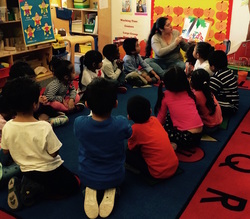Language Enrichment
|
The National Institute for Children’s Health and Development recommends at least 1,000 hours of intentional, one-on-one language driven interaction. Taking this to heart, the SED Center Children's Program seeks to boost our children’s language and literacy skills through: conversation, literacy activities, and sign language.
Research shows that by age 3, children from low income families have 30 million less words in their vocabulary than their privileged peers. At such a young age, these children are already behind in the skills they need to be successful in school. (B. Hart, T. R. Risley, 1995) |
Conversation |
Literacy Activities |
|
Infants & Toddlers:
A variety of age appropriate books are provided during Unstructured Interaction Time so that every child is able to explore a book of their choosing and engage in meaningful exchanges about its content. This activity facilitates conversation and exposes children to the mechanics of reading a book, such as opening the book, closing the book and turning its pages. Preschool: A different story is read every week incorporating sign language and highlighting key vocabulary words. The reading is reinforced by movement cues and activities that encourage kinesthetic engagement, such as sorting, matching, puzzles, cooking demonstrations, filling/emptying containers, dramatic play, etc. To see pictures of these activities click here. |
Sign Language |
|
Sign language, or symbolic gesturing, is incorporated into all language driven interactions, creating new connections in the brain and providing additional ways of storing information.
Signing with young children boosts brain development, increases vocabulary and has been known to provide students with an approximate 12 point verbal IQ advantage over their non signing peers (Acredolo, L. P., & Goodwyn, S.W., 2000). Growth in children’s receptive language, regardless of which language, is positively related to reading outcomes in first grade, both within and between their languages (Davison, Hammer and Lawrence, 2011). To see pictures of these activities click here. |




